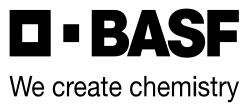Smoulder
Group 2 & 14
Effective control of broadleaf weeds in a pre-seed application to start the season with cleaner fields.
- Post-emergence burndown of emerged weeds and residual pre-emergence control of secondary flushes of volunteer canola prior to seeding wheat and barley
- Control of tough winter annual and perennial weeds like narrow-leaved hawk’s beard, dandelion and Canada thistle
- Burndown control of resistant broadleaf weeds, including biotypes of kochia resistant to Group 2, 4 and 9
Labels & SDS
9 AVAILABLE
Labels & SDS
Benefits of Smoulder
- Smoulder provides post-emergence burndown control of broadleaf weeds.
- Smoulder provides residual pre-emergence control of secondary flushes of volunteer canola.
- Smoulder contains Group 2 and Group 14 ingredients to provide modes of action for effective control of many weeds, including resistant weeds.
Performance Trials
Residual volunteer canola control, 22-50 DAT
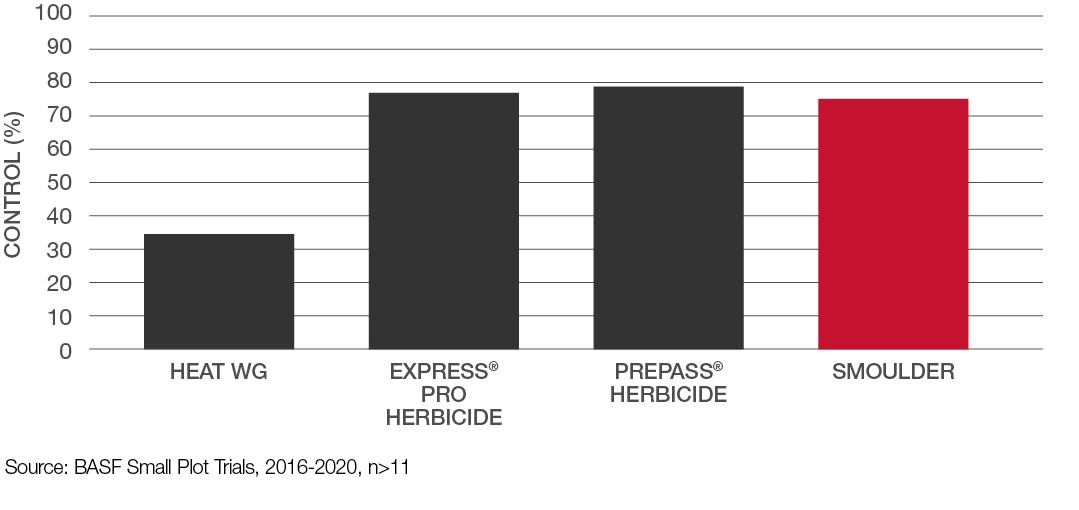
Enhanced annual burndown performance, 11-19 DAT
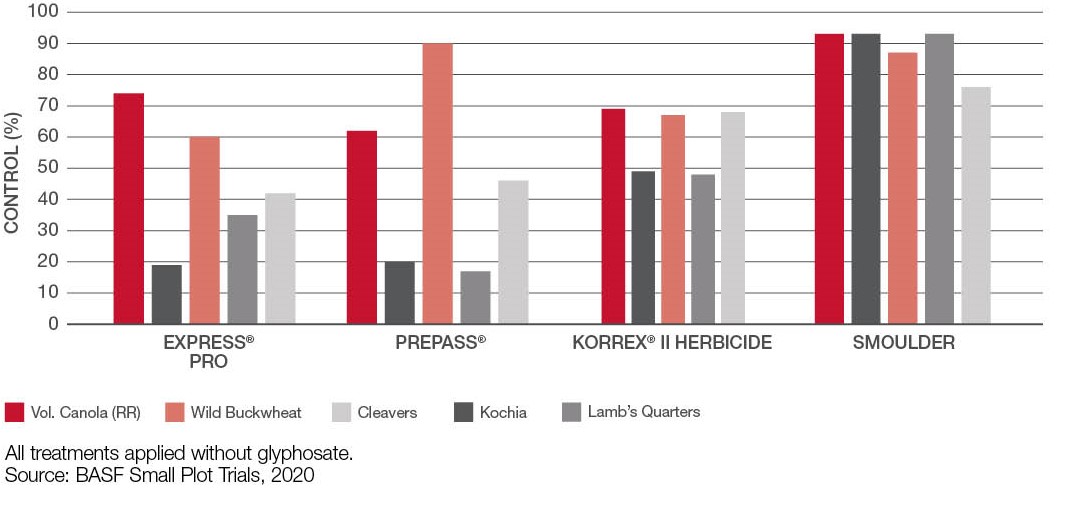
Perennial/winter annual weed control, 28-36 DAT
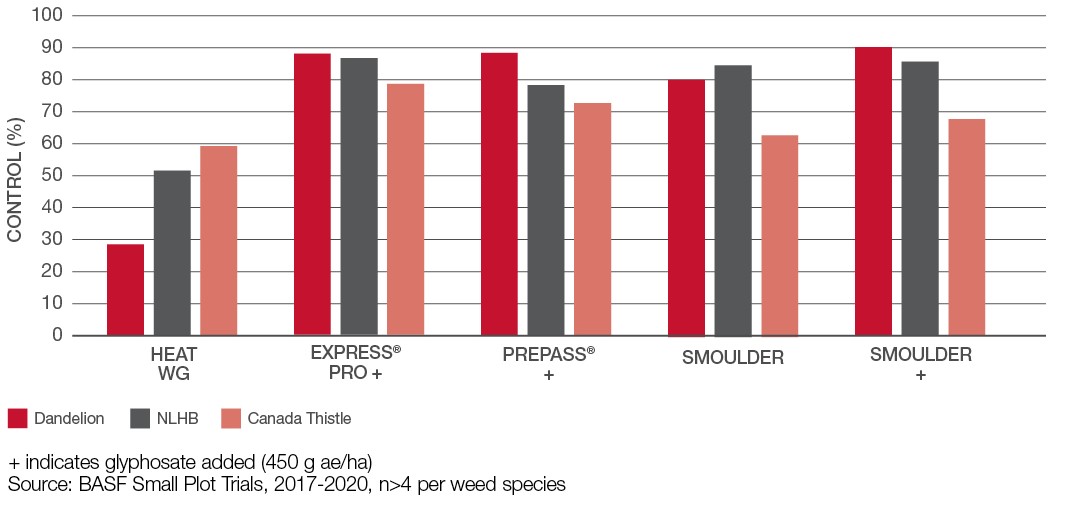
Extended residual control of Roundup Ready® canola, 35 DAT
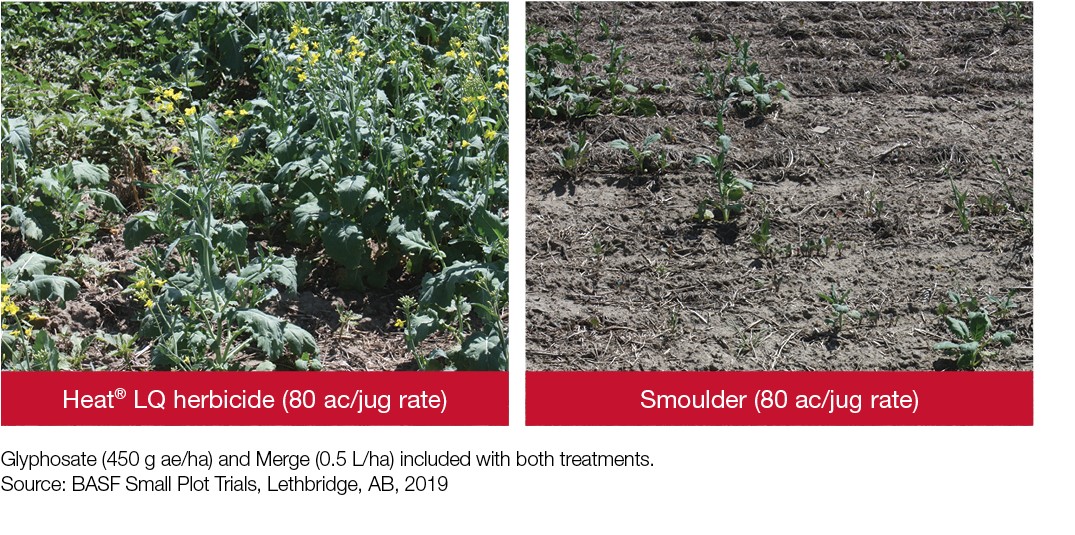
Product Info & Application Guide
Weed Management
Weed Class |
Weeds Controlled1 |
|---|---|
Broadleafs - 8 leaf (except where indicated) |
Canada fleabane (15 cm) |
1 When applied with glyphosate. It is recommended that Smoulder only be used when tank mixed with glyphosate.
2 Including biotypes resistant to Group 2, 4 and 9.
3 Provides control of secondary flushes (including Roundup Ready® and LibertyLink®) in addition to burndown control of volunteer canola (all types).
Application Tips
Restricted entry interval - 12 hours.
Do not use on soils that have large gravelly or sandy areas, eroded knolls or calcium deposits.
Do not apply during periods of dead calm or gusty winds.
Pre-harvest interval
60 days when used as a pre-seed application.
Grazing
Wheat and barley forage may be used as feed (hay or sileage) or grazed 30 or more days after application.
When to Apply
Crop |
Staging |
|---|---|
Barley |
Pre-seed |
Wheat (incl. durum, spring and winter) |
Pre-seed |
How Much to Apply
One case of Smoulder herbicide will treat 80 acres.
Crop |
Application Rate |
|---|---|
Barley and wheat |
11 g/ac (28 g/ha) |
Post-harvest4 |
11 g/ac (28 g/ha) |
All Applications
| Merge | 200 to 400 ml/ac (0.5 to 1 L/ha) |
Water Volume
| Ground application | 20 to 40 L/ac (5 to 10 gal/ac) |
4 Post-harvest application is only to be used prior to seeding wheat, barley and oats.
Mixing Order
- Use a 50-mesh filter screen and fill clean spray tank 1/2 full of water. Start agitation system.
- Add the required amount of Smoulder herbicide and continue agitation until completely dissolved and product is fully dispersed.
- Add in glyphosate.
- Add the required amount of Merge adjuvant.
- Continue agitation while adding the remaining amount of water to fill the tank.
- Continue to agitate or the run the by-pass system.
- After any break in sprayer operation, agitate thoroughly before spraying again.
Sprayer Cleanout Instructions
- Immediately after spraying, completely drain the spray tank.
- First rinse: Fill tank 1/10 full of water; rinse spray tank for 15 minutes; flush through booms and hoses. Remove all end caps or open ball valves and flush solution through boom ends. Drain tank completely.
- Second rinse: Fill tank with clean water. Add a commercial grade tank cleaner or 1 L of household ammonia (minimum 3% ammonia) per 100 L of water and agitate and flush booms. Agitate for 15 minutes. Remove end caps or opening ball valves to flush booms and hoses after allowing cleaning solution to stand in sprayer tank and booms for several hours or overnight. Drain tank after flushing boom and hoses. Clean nozzles and screens separately with a cleaning agent or an ammonia solution.
- Third rinse: Rinse tank with clean water and flush through boom and hoses. Remove all end caps or open ball valves and flush solution through boom ends. Drain tank.
Tank Mixes
Glyphosate only.
Contact your local BASF AgSolutions® Grower or Retail Representative or call AgSolutions Customer Care at 1-877-371-BASF (2273) for additional information on supported tank mixes.
Follow Crops
24 hours after pre-seed application
Barley, wheat (durum, spring and winter)
11 months after application
Canola (all types), faba beans, field corn, flax5, Clearfield® lentils, peas, soybeans
Following season after post-harvest application
Oats, spring barley, wheat (spring or durum)
5 Flax may only be seeded 11 months after application in Black and Dark Brown soil zones. In the Brown soil zone, flax may be seeded 22 months after application.
